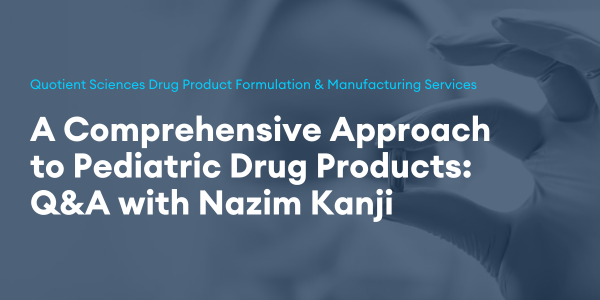Summary: Quotient Sciences focuses on advancing pediatric drug products, addressing the gap in approved pediatric treatments compared to adults. Some challenges that Quotient Sciences address in pediatric development include taste aversion, the need for age-appropriate formulations, and food compatibility studies. Our tailored solutions through combine formulation development, manufacturing, and clinical pharmacology to meet clinical and regulatory goals.
Despite the rising demand for pediatric dosage forms, the number of approved pediatric drug treatments on the market remains significantly less than those for adults.
Understanding the ongoing need for advances in pediatric drug products, Quotient Sciences combine pediatric formulation development expertise with global drug product manufacturing and clinical pharmacology services to help your program succeed by providing tailored solutions to meet clinical, regulatory, and commercial goals.
Learn more about our experience in pediatric development: our expert Nazim Kanji, Executive Director of Pediatric Services, addresses some common questions that we’ve received about pediatric drug development.
Can you describe a challenging pediatric product that you worked on? What did Quotient Sciences do that helped accelerate the timeline for that project?
Pediatric projects can present our development team with several challenges and risks. These can include aversive taste properties of the drug molecule that require taste masking to ensure palatability of the drug product, development of a single age-appropriate formulation to cover a wide target age group, and the need for suitable stability of the drug in liquid formulations such as solutions and suspensions.
Quotient Sciences integrated CRDMO approach to pediatric programs is designed to avoid delays and ensure data-driven decisions at all stages.
To minimize risks in pediatric drug development, we can design integrated pediatric development programs to initially undertake an upfront taste characterization study of the drug substance alone and in combination with suitable flavors and sweeteners. This confirms the taste masking and formulation development strategies to be pursued.
Then, we follow formulation development of multiple formats in parallel to identify lead prototypes to proceed with clinical assessment of the proposed pediatric formulations in adult panels. This allows for dosage forms to be optimized and clinically-validated based on taste and/or pharmacokinetic attributes prior to progressing into pediatric trials.
An example of an integrated pediatric program is the development of an age-appropriate formulation of Belumosudil1 which is used for the treatment of chronic graft-versus-host disease.
We initially set out to assess baseline taste of Belumosudil and screen various flavor/sweetener combinations in 12 healthy adult volunteers. The test articles comprised of drug in bottle samples which were reconstituted with aqueous vehicles that included no sweetener and no flavor. This was the reference, sweetener alone and different flavors with sweetener in combination.
All reconstituted samples were tasted by all subjects in a single day. Data was captured via taste questionnaires and decisions were then taken based on median & mean scores to determine the lead taste masking systems.
Human data confirmed that sweetener alone or in combination with a flavor could enhance the palatability of Belumosudil and that a suspension formulation would be suitable for development and progression into pediatric trials.
Following the taste assessment study, we developed a novel, bespoke pediatric suspension formulation, conducted a relative bioavailability study, and confirmed the palatability of the suspension formulation as part of that study.
Who owns the IP for new formulations – Quotient Sciences or the client?
The client does. We have not claimed any IP for past projects.
Given the existence of the STEP database, can you elaborate on what information is in your internal excipients database?
The STEP database is a great resource for information on pharmaceutical excipients that may have used in pediatric formulations. We have also compiled information into an internal excipients database to guide our development teams.
At Quotient Sciences, as part of our pediatric development programs and in order to come to a view on the suitability of excipients for the target age groups, we assess a number of information sources on excipients which include the STEP database and acceptable daily intake levels, as well as prior use in recently approved pediatric products.
Since many of our pediatric formulations include suitable flavors and sweeteners for taste-masking, we have added information about these agents to our database as a guide for our development teams.
Can you describe how you perform food compatibility studies as it is impossible to test all foods and beverages?
Many pediatric dosage forms, such as sprinkles, granules, and minitablets, can be co-administered with food to aid in dose delivery and palatability.
There are 27 commonly used vehicles listed in draft guidance provided by the FDA. However, we typically undertake in-use food compatibility studies with 3 or 4 soft foods and/or beverages that are selected in consultation with the sponsor.
Foods to evaluate may be selected by undertaking a visual screen of the drug product in various food vehicles to assess drug product integrity.
In addition to vehicle selection, additional key considerations include the volume of the vehicle, which is generally a spoonful or 5–15 mL, the mixture preparation, handling, and the holding period. At given timepoints during the holding period, we assess samples for assay, related substances, and dissolution.
What is the minimum age of volunteers that are used in healthy volunteer studies?
The minimum age of volunteers for healthy volunteer studies (including both pharmacokinetic and taste assessment) performed in our clinics in the USA and UK is 18 years old.
We do not conduct clinical trials with children at Quotient Sciences.
Have you experienced any specific taste challenges for pediatric products that you developed that have proceeded into phase 2 studies?
We have developed numerous pediatric formulations selected based on taste assessment studies that have proceeded into pediatric efficacy studies.
The taste assessment studies we perform typically assess multiple test articles in a single day. These may include alternative flavors, sweeteners, and different concentrations in combination.
All volunteers in the clinical cohort taste all test articles and complete a taste assessment questionnaire after tasting a product. At the end of that study, we analyze all taste data to identify the most palatable systems to proceed with into Phase 2 studies.
To date, we have not received any negative taste feedback from any pediatric efficacy studies.
Does Quotient Sciences have packaging capabilities for minitabs?
Yes, Quotient Sciences can fill minitabs into capsules at our drug product manufacturing facility in Philadelphia, PA.
How are minitabs dosed to newborns?
In our experience, minitabs intended for dosing to newborns are dispersed in a small volume of water or other appropriate liquid, then dosed intraorally using an oral syringe.
Over the last few decades addressing pediatric formulation and development, we know that patient needs and regulatory requirements are the driving elements in the development of age-appropriate formulations, so we always keep these top of mind in a pediatric program.
Learn more about our pediatric drug development capabilities.
References:
1. Schueller, O., Regev, G., Singh, N., Willson, A., Beville, M., Kanji, N., Lohmer, L., & Patel, J. (2024). Two-part phase 1 study to evaluate the taste profile of novel belumosudil oral suspensions and assess the relative bioavailability and food effect of the selected belumosudil oral suspension compared with oral tablet reference in healthy male participants. Clinical Pharmacology in Drug Development, 0(0), 1–8. https://doi.org/10.1002/cpdd.1378
In our experience, minitabs intended for dosing to newborns are dispersed in a small volume of water or other appropriate liquid, then dosed intraorally using an oral syringe.
Over the last few decades addressing pediatric formulation and development, we know that patient needs and regulatory requirements are the driving elements in the development of age-appropriate formulations, so we always keep these top of mind in a pediatric program.
To get alerted about new blogs, news, and updates from our company, make sure you're on our mailing list. Subscribe for email updates.

